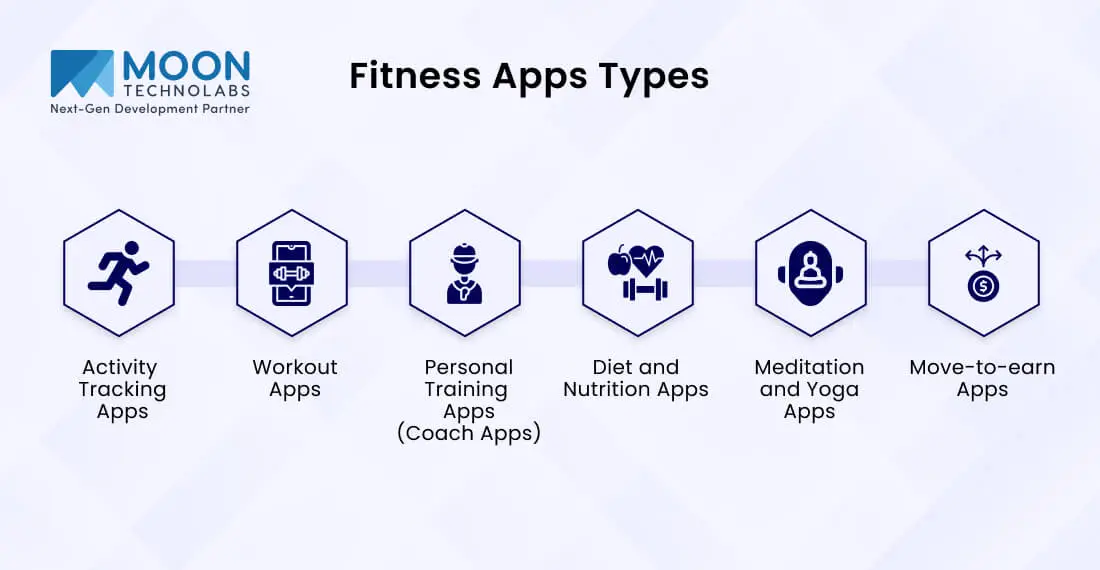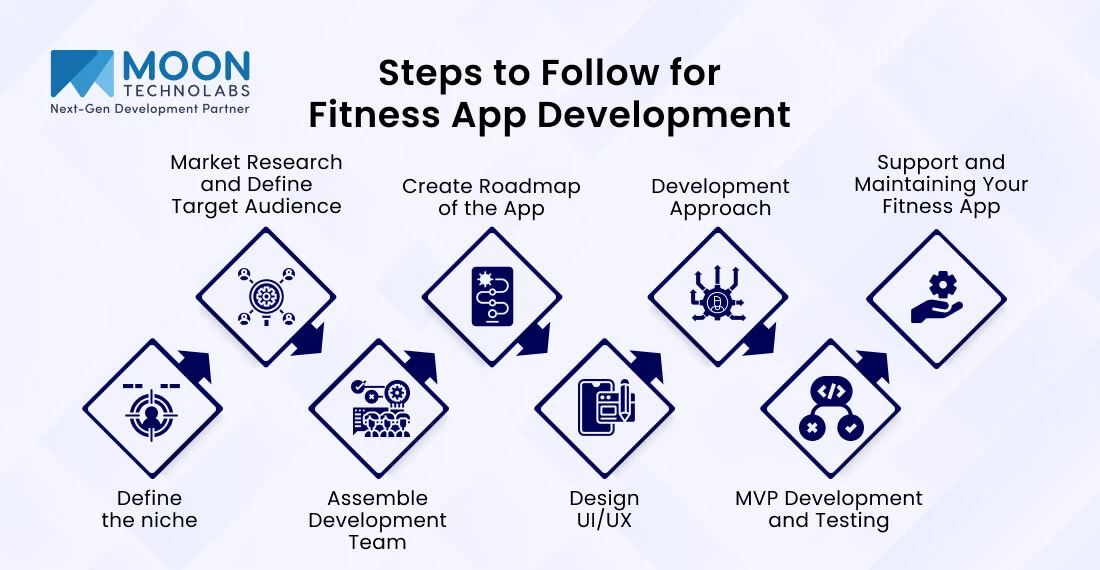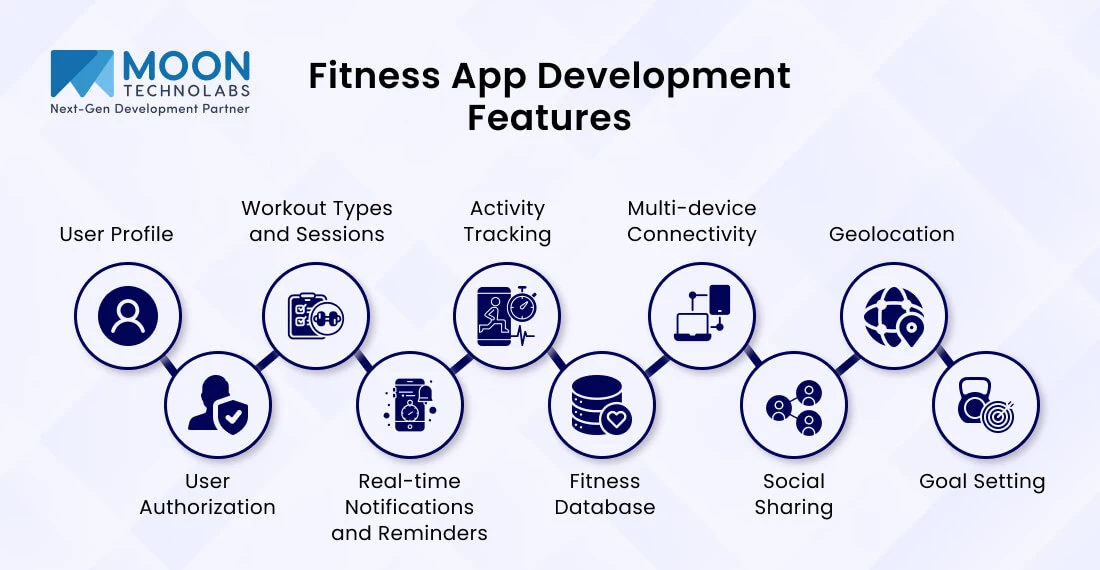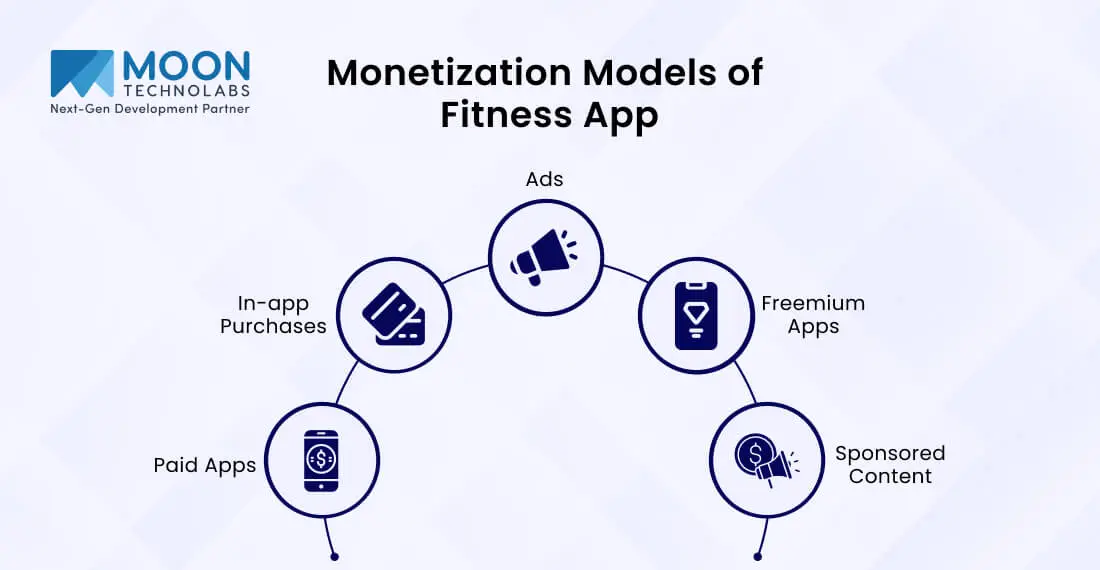Table of Content
Blog Summary:
From choosing the right fitness app type to implementing essential features, this guide has you covered. We delve into the costs, explore various monetization models, and walk you through the steps to build a successful fitness app in a competitive landscape. Get ready to pull up your socks and create an app that dominates the market.
Table of Content
In the world of fitness, where gyms are packed, and workout trends come and go, a new era has dawned: the era of fitness app development. From tracking calories to finding a personalized and convenient way to stay fit and motivated, you can build an app with unique goals.
By developing cutting-edge fitness apps, you can empower individuals to achieve their health and wellness aspirations. A well-crafted fitness app can be your secret weapon to turn fitness into a fun and rewarding experience for your users.
To bring your fitness app vision to life, you need an app development team that understands the industry and can deliver exceptional results. We’ll help you develop a fitness app that stands out from the crowd through this blog.
Over the last few years, fitness app development has taken the market by storm, sprinting forward with health-conscious consumers. Statista predicts that the global user penetration of fitness app users will grow considerably, from 11.6% in 2024 to 13.2% in 2029.
The biggest contributor to the fitness app market is the use of wearable devices that offer personalized experiences. AI and ML have uplifted fitness experiences with gamification and virtual classes, which makes developing a fitness app worth all the hype. A report by Predence Research predicts that the global fitness tracker market will touch USD 259 billion by 2032.
As social fitness gains momentum, workouts have become shared and personalized experiences with real-time activity tracking and healthy lifestyles to achieve fitness goals. According to Allied Market Research, the fitness and health app market is projected to generate revenue of up to USD 120.3 billion by 2030, at a CAGR of 24.3% from 2020.
The current trends in the fitness industry have brought us some of the market dominators, such as Runtastic, Asana, Adidas AG, Asics, MyFitnessPal, Nike, and Fitbit.
Developing fitness apps is now almost synonymous with building blocks of users’ health choices. It is clearly seen that almost half of the US consumers are happy to use paid fitness apps when not working out in gyms.
However, to develop fitness applications, you need to be aware of the niches that you can tap into. Let’s head to them:

If you want to entice users to switch to a healthier lifestyle by making them stay active, fitness activity-tracking apps should be on your priority list.
Nike Run Club and ASICS Runkeeper are the two most popular apps in this category, which allow users to track and calculate the calories burned, the steps taken, and sleep data.
These apps use geolocation to log user activity and monitor speed, distance, and routes. Additionally, an accelerometer is integrated with the app to track the number and rhythm of steps while walking or running.
Activity-tracking fitness apps have also been developed, especially for running, cycling, and gym tracking. If you are looking to develop wearable fitness mobile apps to track activities, it could cost around USD 20,000 to USD 1,15,000.
Building a workout app for gym enthusiasts and fitness freaks who don’t like to miss a workout from their schedule can be a revenue booster for your business. These apps are pocket-sized personal trainers that have evolved from mere rep counters to intelligent coaches.
From HIIT workouts to yoga flows, these apps cater to every fitness goal. They have become motivation enhancers with gamified challenges or community support. Many apps offer video tutorials and real-time feedback. Examples include Nike Training Club, Peloton, and Freeletics.
So, if you are looking to invest in this niche, lace up your sneakers, as building a workout app can cost you around USD 40,000 to USD 80,000.
AI and ML have seeped into every nook and corner of technology, and smart training apps are one of the classic examples of their combined power. Smart training apps are like your personal virtual training coaches for your user base.
They can analyze performance, adjust workouts in real-time, offer personalized tips with 3D motion tracking for estimating poses, monitor posture and form with ML, and even help identify the right weights to lift.
Jefit, PocketGym, Fitbod, and StrongLifts 5×5 are some inspirational examples of AI-powered smart coaching apps. Developing a similar fitness app business model can cost up to USD 30,000 to USD 50,000.
Bring your users out from the maze of diet and nutrition apps by building an app that serves as a personal nutritionist, always on hand to guide them towards a healthier and happier version.
Developing a diet and nutrition meal planning app is a great way to allow your users to track their calories by accurately logging their meals and drinks. These apps are the perfect way to make them stay accountable and also help them discover delicious recipes from a vast food database.
You can integrate barcode scanning features into these apps to log nutritional information about products before using them. Additionally, they can help users track water consumption and organize groceries.
Top apps like MyFitnessPal, Lose It!, Cronometer, and Carb Manager have already transformed lives. So, the fitness app development cost for this segment will be around USD 15,000 to USD 80,000.
Yoga and Meditation apps offer your users a personal sanctuary, a space to relax and recharge, where they can escape the daily grind and find inner peace. These apps have powerful features such as guided meditations, yoga sequences, breathing techniques, and mindfulness training.
Additionally, it enables users to keep track of their progress, bringing consistency to their daily Yoga practice. With personalized recommendations and reminders, users can customize their practice sessions to improve their mental and emotional well-being.
The cost of developing a meditation and yoga app can range anywhere from USD 15,000 to USD 80,000 for a basic to premium app. Some popular examples include Headspace, YogaStudio, Daily Yoga, and Calm.
With the crypto craze taking over the industry, it has spawned a new fitness trend: move-to-earn apps. These game-like apps reward users for exercising by paying them in cryptocurrency or tokens.
It’s almost like your users are making their sweat and hard work count by getting paid to sweat! You can use your rewards to buy in-app items, trade them for other cryptocurrencies, or even invest in other blockchain projects.
Move-to-earn apps combine fitness with blockchain technology and augmented reality to enhance the gameplay. Sweatcoin is one of the pioneers in this space, tracking your steps and rewarding you.
Integrate your app with the latest fitness devices to provide tailored workouts for your users.
Join the Fitness App Revolution
Choose a fitness app development company that will help you select the right mix of technologies, architecture, and interfaces. Of course, choosing between iOS and Android platforms is also going to play a huge part. However, if you’re not sure where, when, and how to start the app development process, here’s a heads-up:

The first step should be to ask the following question: What sets your fitness app apart? Are you focusing on weight loss, muscle gain, yoga, or a specific niche like running or cycling?
The initial step should be deciding on platforms that will help you narrow down devices like tablets, mobile phones, or TVs. A well-defined niche will help you tailor your app’s features and marketing strategy.
Identify your target audience and their specific needs based on the insights from the first step. The question you should ask here is: What is the app’s USP, and how would users use it?
This would be a good time to analyze other popular apps and their features in your target market. Hence, you should conduct interviews, create user personas, define their problems and interests, and analyze the data to build the right features.
Consider your budget and project requirements when deciding whether to hire in-house developers or get in touch with a fitness app development company for outsourcing. We recommend outsourcing as it will be cheaper than hiring agencies or freelancers.
A good way to choose them is to look into their proven track record in mobile app development and passion for fitness. Moreover, they can provide you with an alternative perspective to your vision.
Creating a fitness mobile app architecture is how you validate your idea into a concept now that you have actionable insights to enrich your business analysis.
This is where you’ll add features for workout databases, personalized plans, tracking activities and diet, gamification, and social media. All of this will help you develop customer journeys and set the main objectives.
Besides your research, you also have the development team’s vision that you can use to develop core features. With the user personas and market insights, you can develop a working prototype to test among target users.
It will help you understand the user flow without any coding to collect feedback on the interface, and it doesn’t have any unnecessary screens or features.
Depending on budget, timeline, and features, you can choose between separate iOS and Android apps or cross-platform apps and hybrid apps.
Native apps will use Kotlin, React Native, and Swift, while cross-platform apps can be written in Flutter to save costs and time and increase mobile app performance. Your tech stack will also include backend technologies like Node.js and Python (Django or Flask). For databases, you can choose PostgreSQL and MySQL.
Minimum Viable Product (MVP) is a basic version of your app with core features. Focus on building the essential functionalities that provide value to your target audience.
Once your MVP is ready, the quality analysis team will conduct thorough testing to identify and fix bugs before launching on app stores. We also do beta testing with a small group of users to gather feedback and make necessary improvements.
This is an ongoing phase where each part and feature of the app is tested after every new iteration. The development team tries to maintain and support the app by adding new integrations like sensors and scanners.
It also includes compliance with health standards like HIPAA and making the app more secure with user authentication methods.
With some basic essential fitness app features, you have a lot of scope for choosing from different mobile app ideas for fitness apps. These features form the foundation for creating engaging experiences, from personalized profiles to social interaction, that will set your app apart.

The user profile provides a personalized hub where users can input details like age, weight, height, fitness goals, and preferred workout types. This information will be crucial for tailoring the app’s recommendations and providing a truly customized experience.
Implement secure login options like email/password, social media login, or biometric authentication (fingerprint, facial recognition) to protect user data and ensure seamless access. Consider additional fitness mobile application security measures like two-factor authentication for enhanced protection.
You can offer a range of workout options to cater to different fitness levels and preferences, including high-intensity interval training (HIIT), yoga, pilates, and cardio. The feature also provides detailed workout plans and demonstrations with the option to create custom workouts by integrating live fitness classes and saving their favorites.
Send reminders for upcoming workouts, congratulate them on achievements, and offer personalized tips in addition to in-app chat. Use push notifications strategically to deliver relevant information at the right time, such as workout suggestions based on their location or weather conditions.
Provide clear and visually appealing dashboards that can be monitored with wearable devices. Allow users to set daily, weekly, and monthly activity goals and provide progress updates and rewards. Offer personalized insights based on calories burned, heart rate, sleep patterns, and workout performance.
Build a comprehensive library of fitness workouts based on muscle groups, equipment requirements, and difficulty levels with descriptions, video demonstrations, and step-by-step instructions. Allow users to search and filter exercises based on their preferences and fitness goals with updated variations based on user-generated content (UGC).
Provide seamless synchronization of data and user preferences across different devices (smartphones, tablets, wearables) for a consistent experience. Allow users to start a workout on one device and continue on another without losing progress or data.
Allow users to connect with friends, family, and fellow fitness enthusiasts with features for adding likes, comments, and shares. Enable features like friend invites, workout challenges, leaderboards, and the ability to share achievements on social media platforms.
Utilize fitness app development services like GPS technology and map integration for navigation to track outdoor workouts, map routes, and directions, and allow users to discover nearby fitness facilities and workout areas. Offer features like location-based workout suggestions, guided running or cycling routes, and the ability to save favorite workout spots.
Help users set clear and achievable fitness goals for weight loss, muscle gain, improved endurance, or overall well-being. Provide goal-tracking tools and progress visualization to keep users motivated and focused, offering personalized support by adjusting workouts and diets.
Develop an app that offers expert guidance and personalized workouts.
Starting the fitness app development with an MVP would cost around USD 20,000 to 30,000 since it would be a basic feature app. However, once you have gauged user interest and want to develop a full-fledged fitness app, the cost may rise from USD 50,000 to USD 1,45,000.
If you plan to integrate AI and ML, Bluetooth with hardware connectivity, and video and voice integration, the cost would be USD 10,000 to USD 15,000. Hiring and outsourcing mobile app development services from Moon Technolabs will give you that edge, as we offer the most accurate cost estimates of projects based on your budget, timeline, and feature set.
For a tentative estimate of a basic MVP, the documentation phase can take 70+ hours, whereas the design and development stages will add up to 900+ hours. Here’s a cost breakdown of features for your consideration:
| Features | Est. Development Time | Est. Development cost in USD |
|---|---|---|
| User signing and profile | 120 | 9500 |
| Home screen | 70 | 4500 |
| Workout database | 110 | 7000 |
| Diets | 125 | 6200 |
| User dashboards | 135 | 7500 |
| Push and in-app notifications | 40 | 2000 |
| Server and API | 45 | 1800 |
| Admin panel | 140 | 12000 |
| Subscription plans | 60 | 4800 |
| User navigation/architecture | 75 | 3800 |
| Total | 1075 hours | 59100 |
You can develop a fitness app and turn it into a cash cow by offering basic features for free and charging for premium ones, like expert workouts or personalized meal plans. Selling workout gear or power-ups and partnering with brands for sponsored content or product placements can also bring in extra cash.

Charge a one-time fee for full access, offer premium features for an upgrade, or provide exclusive content with a subscription. You can even offer different subscription levels to match your app’s value and target audience.
Make your app more attractive with personalized coaching or meal plans, bundling them up with users’ favorite features and creating a sense of urgency with limited-time offers.
Place banners between screens to reward users for watching videos. Integrate targeted ads based on user data and offer an ad-free option to boost your app’s bottom line.
You can offer your users a sneak peek into the world of fitness by offering a basic version of your app for free. Then, you can tempt them with premium upgrades that offer even more value.
Collaborate with brands to create sponsored content, integrate their products into your app through affiliate marketing, or partner with influencers or athletes to reach a wider audience.
Build an app that learns and adapts to user needs across multiple devices.
Get in Touch for a FREE Quote
Imagine your fitness app as a personal trainer who’s always there, motivating, guiding, and celebrating your users’ progress. With Moon Technolabs besides, your next big idea for developing a fitness app can become the go-to destination for fitness enthusiasts, offering personalized workout plans, engaging challenges, and a supportive community.
With careful planning and a talented team, you can create a digital coach that inspires users to reach their fitness goals. Our expertise in fitness app development, combined with our passion for innovation, will help you build an app that stands out from the crowd. Check out how we did it for one of our clients, Freelap.
Let’s work together to create a fitness app that makes a lasting impact and transforms lives.
01
02
03
Submitting the form below will ensure a prompt response from us.